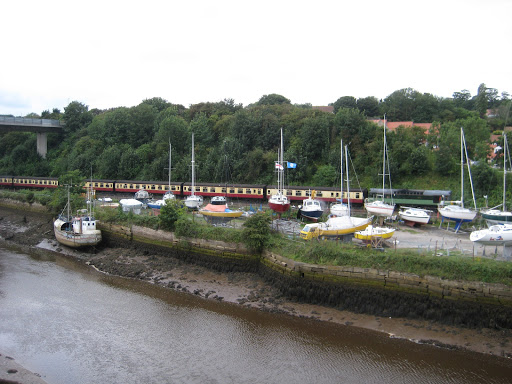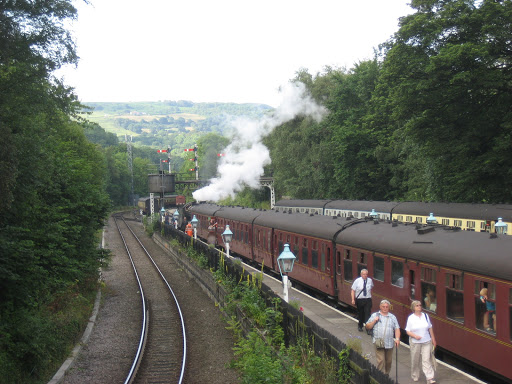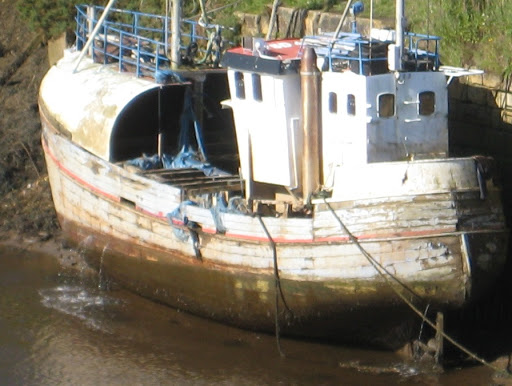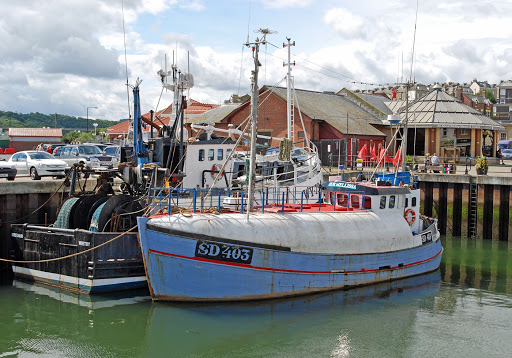It was great to be out on the North York Moors again, although there was a time when I would not have said that. It is where my first proper walks were, with boots, cagoule and rucksack, fifty years ago. My friend Neville used to drive us up on Saturdays in his Ford Anglia and we would spend the day walking. Don’t ask me where: the names Helmsley and Chop Gate sound familiar. Neville had been walking for longer than me and knew all the routes. He persuaded me along and I just followed – literally.
More often than not he would disappear off into the distance and leave me trailing behind in wretched misery, with swollen ankles, and feet blistered by badly fitting boots. That first pair was fine for a few miles but I could never get the right combination of thin and thick socks to avoid rubbing. Nowadays I wear just one thick pair and stick on a piece of micropore tape at the slightest hint of trouble, which is not very often. As for ankles, from quite an early age I was forever going over and spraining them. I once jumped half way down the stairs and went over with a crunch. The pain was unbelievable. I always went over at least once on Neville’s walks, and still do sometimes, but it doesn’t usually hurt now. Mrs. D. says I’ve got lax ligaments. People cringe when I put the soles of my feet and my knees together at the same time.
On one walk, on Fylingdales Moor near the strange radome “golf balls” (replaced in 1992), I was so far behind I took a wrong fork, and rather than backtrack two hundred yards took a short cut across an area signed “Ministry of Defence. Danger. Unexploded Mines”. I was past caring. Another time, Neville organised a group of us to attempt the Lyke Wake Walk – a 40-mile crossing of the moor from Osmotherly to Ravenscar – but I had to give up less than half-way with one ankle puffed-up like a balloon, and red-raw heels and toes. My heels had blisters upon blisters and my toes looked like they had been stripped with sandpaper. It showed the world for what it is: the beauty and the pain.
The beauty won: the beauty of the Yorkshire countryside. Somehow, I persisted, and my feet, ankles and even I toughened up. We walked in all weathers. I must have been very warm-blooded
because, even in the coldest winds and wettest rain, I wore only a
cagoule over t-shirt and jeans. I would even go out like that in ice and
snow. Now, maybe ten pairs of better-fitting boots later and owner of warmer clothing, I wish I got out more often. So, on holiday last month, it was great to be out on the North York Moors again. One walk was around the enigmatically-named Hole of Horcum.
 |
| Panorama of the Hole of Horcum, 2007 (Adam Jennison, Wikimedia Creative Commons) |
The Hole of Horcum is a huge natural amphitheatre 400 feet deep and three-quarters of a mile across, just west of Fylingdales Moor. Legend has it as ‘The Devil’s Punchbowl’, formed when a giant threw a handful of earth at his wife. That doesn’t make much sense to me. Apart from the fact that no one would even dream of throwing a handful of earth at his wife, the giant was called Wade, not Horcum. I think Horcum must have been his dog, one of those enormous English Mastiffs, and the hole is where he buried a bone and then dug it up again. In any case, curmudgeonly geo-morphologists have to go and spoil things by telling us the Hole was formed by a process of water-erosion called spring-sapping?
 |
| The Hole of Horcum, 17th August 2020 |
My own picture is from roughly the same viewpoint as the panorama, taken from the edge of the hole soon after we began circling anti-clockwise. The purple heather was putting on a better show this year. On reaching the far right-hand side we went off at a tangent along a path to a five-way junction at Dundale Rigg (what a name for a folk band!). From there you can divert to Skelton Tower (an 1830s shooting lodge) and marvel at the steam trains on the North Yorkshire Moors Railway far below. However, we continued on to the sleepy village of Levisham and then looped back East and North along the side of a wooded valley, picking our way through nettles to reach the footpath across the floor of the Hole, visible in the above photograph. In seven miles we had walked the whole of Horcum.
 |
| Levisham Village |
 |
| Entering the Hole of Horcum, 17th August 2020 |
Another day we walked along the cliff top, along the track bed of the old Whitby to Middlesborough Middlesbrough railway, which closed in 1958. Some of the now-dismantled structures along the line, such as the Staithes Viaduct, were remarkable. At Staithes you can still make out the brick abutment on the hillside across the valley from the village car park that was once the site of Staithes railway station. The viaducts survived as potential Second World War targets only for unaffordable maintenance costs and declining passenger numbers to achieve what Hitler did not.
We joined the track at Sandsend, following in the footsteps of the intrepid Mr. Yorkshire Pudding who was there last year, and also ourselves in 1997, with the same two people in the next photograph as above. Whereas Mr. Pudding’s group continued the six miles north to Runswick Bay, we turned inland towards the village of Lythe and returned to Sandsend by a higher path across fields, giving a bird’s eye view of the resort.
 |
| The old railway track north from Sandsend, 19th September, 1997, looking towards Whitby Abbey |
 |
| Looking down on Sandsend from the higher cliff path, 16th August 2020 |
The final photograph is from the cliff tops south of Whitby near the Abbey, which gives fine views in the opposite direction, north towards Sandsend. You can see Sandsend and the wooded cliffs where we walked.
 |
| Looking north to Sandsend from near Whitby Abbey, 21st August 2020 |
From the Abbey you descend the famous 199 steps back into town.
For more photographs, this guy’s web site is a real treat:
Sandsend to Runswick Bay
Hole of Horcum (he starts at Levisham).




















































